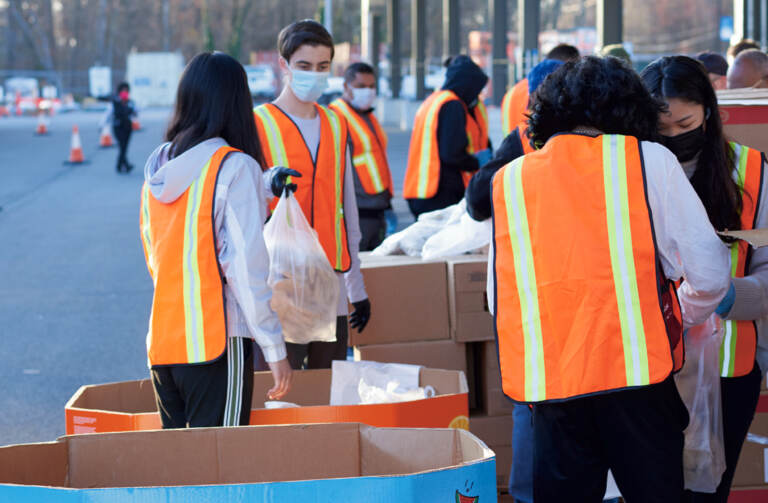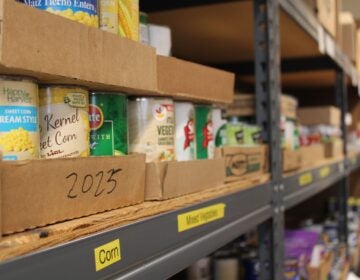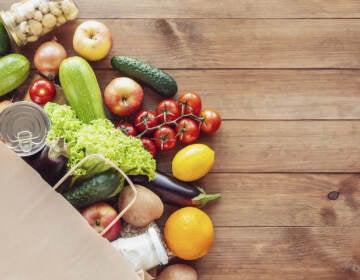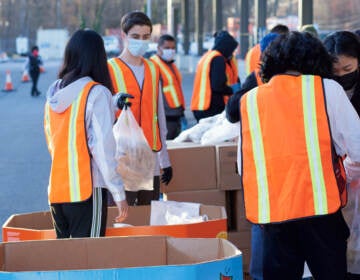Food ‘rescue’ groups feeding the hungry in N.J. as pandemic ebbs
Even as more people return to work, many are struggling with debts built up when they were unable to work or did not collect a regular paycheck.

Workers at the Food Bank of South Jersey load food for distribution to pantries and soup kitchens for Thanksgiving 2021. (Food Bank of South Jersey)
This story originally appeared on NJ Spotlight.
Demand for food assistance is staying high even as the COVID-19 pandemic ebbs, and New Jersey’s food “rescue” groups are playing a critical role in keeping people fed.
Nonprofits collect unwanted but still edible food from retailers and give it to pantries, soup kitchens and community groups who distribute it to those who may still need help feeding their families even if they have gone back to work.
The food may be approaching its sell-by date, or be less than perfect in appearance, but plays an important part in the state’s food-assistance network during what is expected to be a long hangover from the pandemic, according to nonprofit leaders.
Even as more people return to work, many are struggling with debts built up when they were unable to work or did not collect a regular paycheck, and a recent increase in food prices makes it harder to feed a family.
“I would love to say that we’re going out of business but I’m afraid that’s just not the case,” said Julie Kinner, vice president of operations at Table to Table, a nonprofit that rescues food for pantries and soup kitchens in Essex, Hudson, Passaic and Bergen counties. “We’re seeing a lot of people going back to work, which is wonderful. But their back bills over the time they weren’t working or didn’t have a consistent paycheck are catching up to them.”
No letup in demand
The increasing return to work has also created demand for food distribution points that are open outside of work hours, and that has led some of them to open later than they did during the pandemic, Kinner said.
Table to Table distributed about 25 million pounds of mostly perishable food last year, or enough for about 25 million meals. The food comes from supermarkets, grocery stores and distributors who have taken it off their shelves because of coming expiration dates or slight damage, and would otherwise throw it in the trash.
New Jersey’s leading food banks have predicted that demand for food assistance will stay high for months or years after the pandemic fades. They contend that economic distress created by the pandemic will last a lot longer than the public health emergency, and that some people will look for food assistance as they struggle to make ends meet.
The Food Bank of South Jersey, which serves four counties, rescued some 5.6 million pounds of food in 2021, said its chief operating officer, Charles Hosier. “Those donations cut down on food waste and address the critical hunger needs of South Jersey residents,” he said.
Food retailers or users generating more than 52 tons of food waste a year are now required to separate and recycle the waste to comply with New Jersey’s Food Waste Law, which was passed in April 2020. That, plus the efforts of the food-rescue groups, has reduced the volume of food waste but too much is still needlessly thrown away, advocates say.
‘So much food going to waste’
“Even if it was dated that day, I know I can get it into the hands of families that need it,” said Claudia Wheeler, founder and sole operator of the Salt Foundation, a Jersey City-based nonprofit that rescues 800-1,200 pounds of food in a typical a day.
Wheeler said she’s seeing more demand for food now because some volunteer-run pantries are closing down as the pandemic ebbs, leaving their customers looking for other sources.
“During COVID there were a lot of community organizations that wanted to help the community,” she said. “That has gone down a lot and that has increased the amount of food I get and the number of people who come to me.”
She rescues food from Trader Joe’s, Wegmans and Walmart, and redistributes it through food pantries and churches. She also runs her own distribution events and has recently expanded those to twice weekly because “there’s so much food going to waste.”
Carlos Roldan, program director for a food-pantry program run by Catholic Charities in Paterson, Franklin and Dover, estimated that 15% of his total food is rescued from supermarkets and other sources.
The rescued food helps to feed some 20,000 people a month, said Roldan, who gives out 1,000 bags of food a day.
Close to sell-by date
He recently received three pallets of cheese about 10 days before its sell-by date of March 14. The donor decided it would be unable to sell the cheese by that date but Roldan accepted it because he knew it would be in strong demand.
Produce that is beginning to wilt or otherwise looks unsellable is another likely donation, and Roldan knows his clients will gladly accept it. “A lot of vegetables that are starting to look kind of ugly we can take,” he said. “I know we can use them right away.”
His suppliers include Costco in Wayne, which donates six to eight pallets of produce per week, according to a spokeswoman.
But there’s less food available for donation now that people are working and shopping more, the spokeswoman said. “Right now, our sales are picking up so it’s not as much being left over for the next day to be given away. People are going back to work so they are shopping more.”
Donors are motivated by the Food Waste Law, and by a growing awareness that they can reduce waste and feed the hungry at the same time, said Kinner of Table to Table.
“So many of these companies are looking towards the environment, and knowing that they are throwing away good stuff that people should be eating,” she said. “We’re lucky enough to benefit from it.”
WHYY is your source for fact-based, in-depth journalism and information. As a nonprofit organization, we rely on financial support from readers like you. Please give today.






